Financial Decision Making Report: Divisionalisation and Performance
VerifiedAdded on 2022/12/28
|11
|2476
|90
Report
AI Summary
This report delves into the intricacies of financial decision-making, focusing on the divisionalisation of business operations. It explores the advantages and disadvantages of divisional structures, emphasizing the need for distinct management and operational independence while acknowledging potential challenges like resource duplication and a lack of overall objective alignment. The report then examines various techniques for measuring divisional and managerial performance, including Return on Investment (ROI), Residual Income (RI), and Economic Value Added (EVA), with specific application to YoYo Airline. Furthermore, it highlights the significance of non-financial measures in assessing performance, such as customer satisfaction and intangible assets, and outlines the costs associated with different aspects of working capital, including cash, receivables, inventory, and payables. Finally, it proposes methods for controlling these working capital elements to optimize financial performance. This report provides a thorough overview of financial decision-making concepts and their practical implications.

Running head: FINANCIAL DECISION MAKING
Finance
Name of the Student
Name of the University
Author’s Note
Finance
Name of the Student
Name of the University
Author’s Note
Paraphrase This Document
Need a fresh take? Get an instant paraphrase of this document with our AI Paraphraser
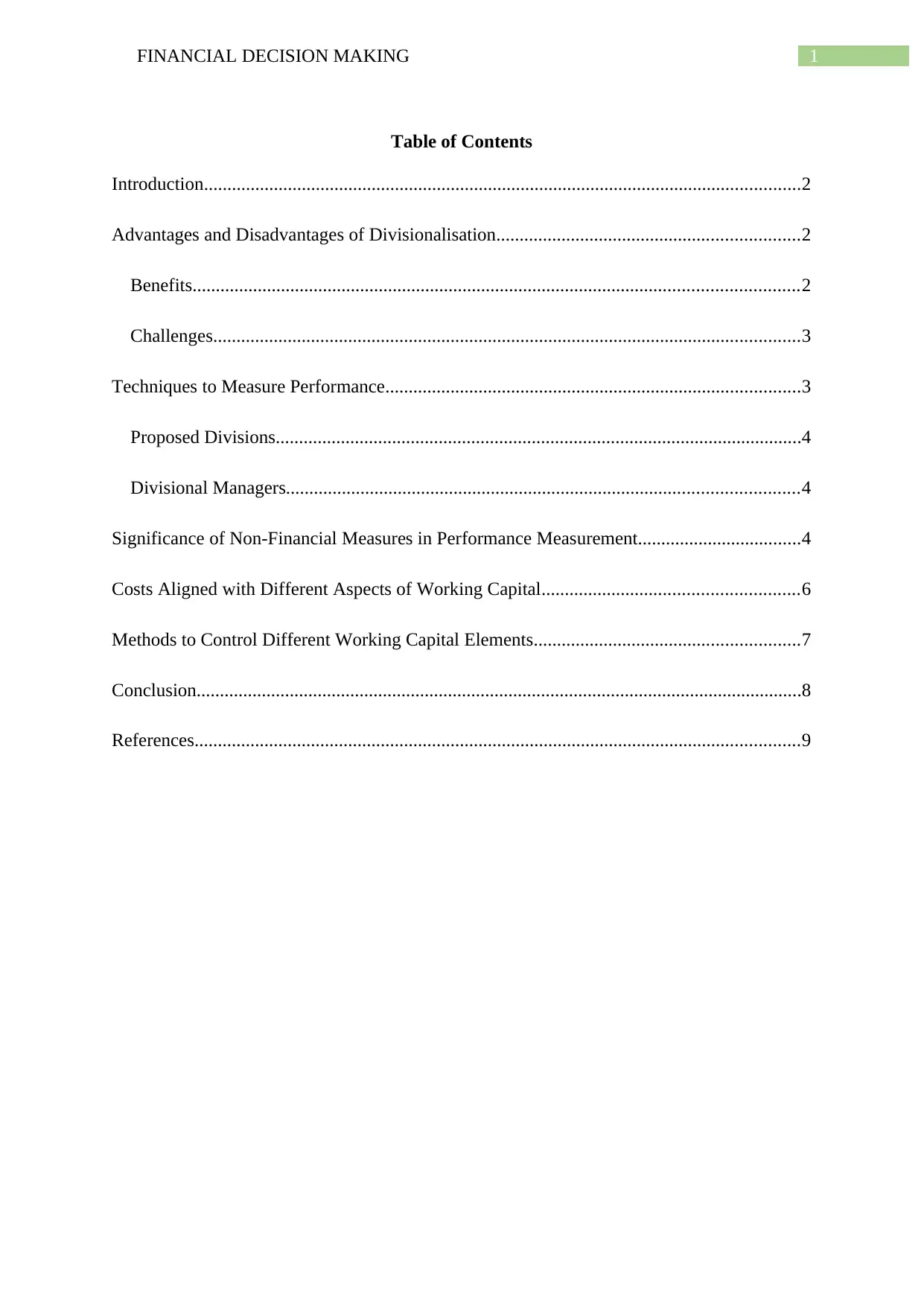
1FINANCIAL DECISION MAKING
Table of Contents
Introduction................................................................................................................................2
Advantages and Disadvantages of Divisionalisation.................................................................2
Benefits..................................................................................................................................2
Challenges..............................................................................................................................3
Techniques to Measure Performance.........................................................................................3
Proposed Divisions.................................................................................................................4
Divisional Managers..............................................................................................................4
Significance of Non-Financial Measures in Performance Measurement...................................4
Costs Aligned with Different Aspects of Working Capital.......................................................6
Methods to Control Different Working Capital Elements.........................................................7
Conclusion..................................................................................................................................8
References..................................................................................................................................9
Table of Contents
Introduction................................................................................................................................2
Advantages and Disadvantages of Divisionalisation.................................................................2
Benefits..................................................................................................................................2
Challenges..............................................................................................................................3
Techniques to Measure Performance.........................................................................................3
Proposed Divisions.................................................................................................................4
Divisional Managers..............................................................................................................4
Significance of Non-Financial Measures in Performance Measurement...................................4
Costs Aligned with Different Aspects of Working Capital.......................................................6
Methods to Control Different Working Capital Elements.........................................................7
Conclusion..................................................................................................................................8
References..................................................................................................................................9
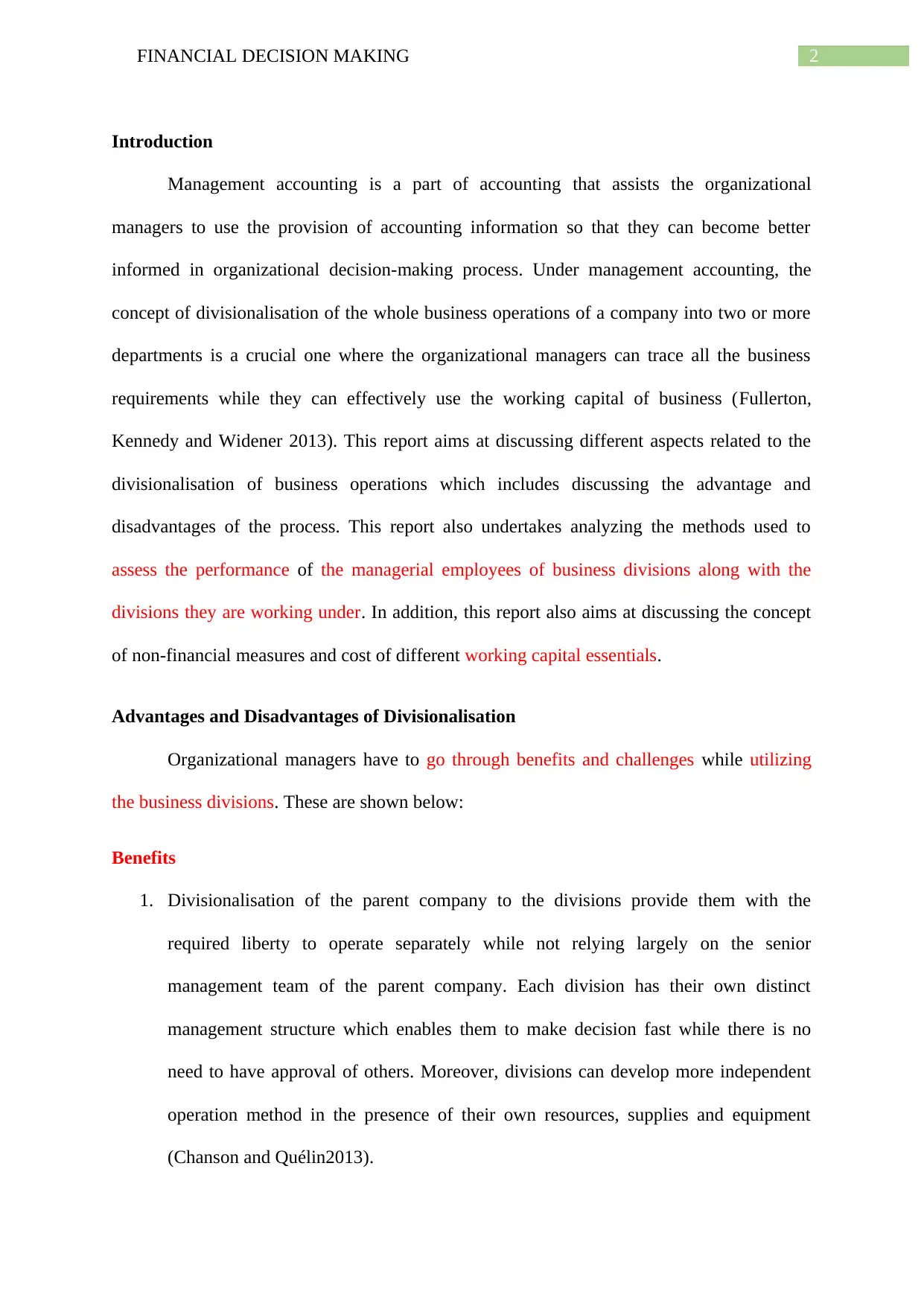
2FINANCIAL DECISION MAKING
Introduction
Management accounting is a part of accounting that assists the organizational
managers to use the provision of accounting information so that they can become better
informed in organizational decision-making process. Under management accounting, the
concept of divisionalisation of the whole business operations of a company into two or more
departments is a crucial one where the organizational managers can trace all the business
requirements while they can effectively use the working capital of business (Fullerton,
Kennedy and Widener 2013). This report aims at discussing different aspects related to the
divisionalisation of business operations which includes discussing the advantage and
disadvantages of the process. This report also undertakes analyzing the methods used to
assess the performance of the managerial employees of business divisions along with the
divisions they are working under. In addition, this report also aims at discussing the concept
of non-financial measures and cost of different working capital essentials.
Advantages and Disadvantages of Divisionalisation
Organizational managers have to go through benefits and challenges while utilizing
the business divisions. These are shown below:
Benefits
1. Divisionalisation of the parent company to the divisions provide them with the
required liberty to operate separately while not relying largely on the senior
management team of the parent company. Each division has their own distinct
management structure which enables them to make decision fast while there is no
need to have approval of others. Moreover, divisions can develop more independent
operation method in the presence of their own resources, supplies and equipment
(Chanson and Quélin2013).
Introduction
Management accounting is a part of accounting that assists the organizational
managers to use the provision of accounting information so that they can become better
informed in organizational decision-making process. Under management accounting, the
concept of divisionalisation of the whole business operations of a company into two or more
departments is a crucial one where the organizational managers can trace all the business
requirements while they can effectively use the working capital of business (Fullerton,
Kennedy and Widener 2013). This report aims at discussing different aspects related to the
divisionalisation of business operations which includes discussing the advantage and
disadvantages of the process. This report also undertakes analyzing the methods used to
assess the performance of the managerial employees of business divisions along with the
divisions they are working under. In addition, this report also aims at discussing the concept
of non-financial measures and cost of different working capital essentials.
Advantages and Disadvantages of Divisionalisation
Organizational managers have to go through benefits and challenges while utilizing
the business divisions. These are shown below:
Benefits
1. Divisionalisation of the parent company to the divisions provide them with the
required liberty to operate separately while not relying largely on the senior
management team of the parent company. Each division has their own distinct
management structure which enables them to make decision fast while there is no
need to have approval of others. Moreover, divisions can develop more independent
operation method in the presence of their own resources, supplies and equipment
(Chanson and Quélin2013).
⊘ This is a preview!⊘
Do you want full access?
Subscribe today to unlock all pages.

Trusted by 1+ million students worldwide
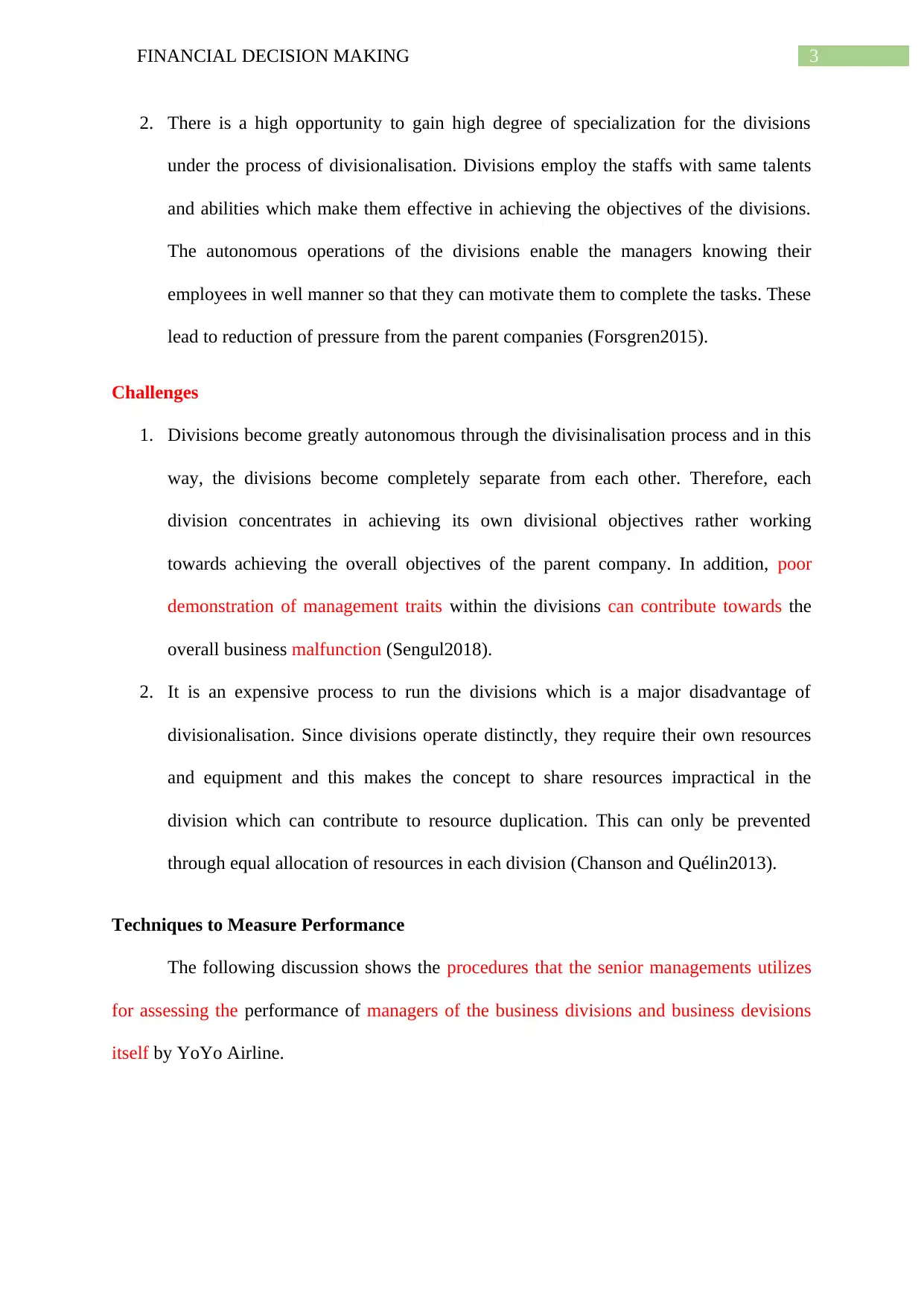
3FINANCIAL DECISION MAKING
2. There is a high opportunity to gain high degree of specialization for the divisions
under the process of divisionalisation. Divisions employ the staffs with same talents
and abilities which make them effective in achieving the objectives of the divisions.
The autonomous operations of the divisions enable the managers knowing their
employees in well manner so that they can motivate them to complete the tasks. These
lead to reduction of pressure from the parent companies (Forsgren2015).
Challenges
1. Divisions become greatly autonomous through the divisinalisation process and in this
way, the divisions become completely separate from each other. Therefore, each
division concentrates in achieving its own divisional objectives rather working
towards achieving the overall objectives of the parent company. In addition, poor
demonstration of management traits within the divisions can contribute towards the
overall business malfunction (Sengul2018).
2. It is an expensive process to run the divisions which is a major disadvantage of
divisionalisation. Since divisions operate distinctly, they require their own resources
and equipment and this makes the concept to share resources impractical in the
division which can contribute to resource duplication. This can only be prevented
through equal allocation of resources in each division (Chanson and Quélin2013).
Techniques to Measure Performance
The following discussion shows the procedures that the senior managements utilizes
for assessing the performance of managers of the business divisions and business devisions
itself by YoYo Airline.
2. There is a high opportunity to gain high degree of specialization for the divisions
under the process of divisionalisation. Divisions employ the staffs with same talents
and abilities which make them effective in achieving the objectives of the divisions.
The autonomous operations of the divisions enable the managers knowing their
employees in well manner so that they can motivate them to complete the tasks. These
lead to reduction of pressure from the parent companies (Forsgren2015).
Challenges
1. Divisions become greatly autonomous through the divisinalisation process and in this
way, the divisions become completely separate from each other. Therefore, each
division concentrates in achieving its own divisional objectives rather working
towards achieving the overall objectives of the parent company. In addition, poor
demonstration of management traits within the divisions can contribute towards the
overall business malfunction (Sengul2018).
2. It is an expensive process to run the divisions which is a major disadvantage of
divisionalisation. Since divisions operate distinctly, they require their own resources
and equipment and this makes the concept to share resources impractical in the
division which can contribute to resource duplication. This can only be prevented
through equal allocation of resources in each division (Chanson and Quélin2013).
Techniques to Measure Performance
The following discussion shows the procedures that the senior managements utilizes
for assessing the performance of managers of the business divisions and business devisions
itself by YoYo Airline.
Paraphrase This Document
Need a fresh take? Get an instant paraphrase of this document with our AI Paraphraser
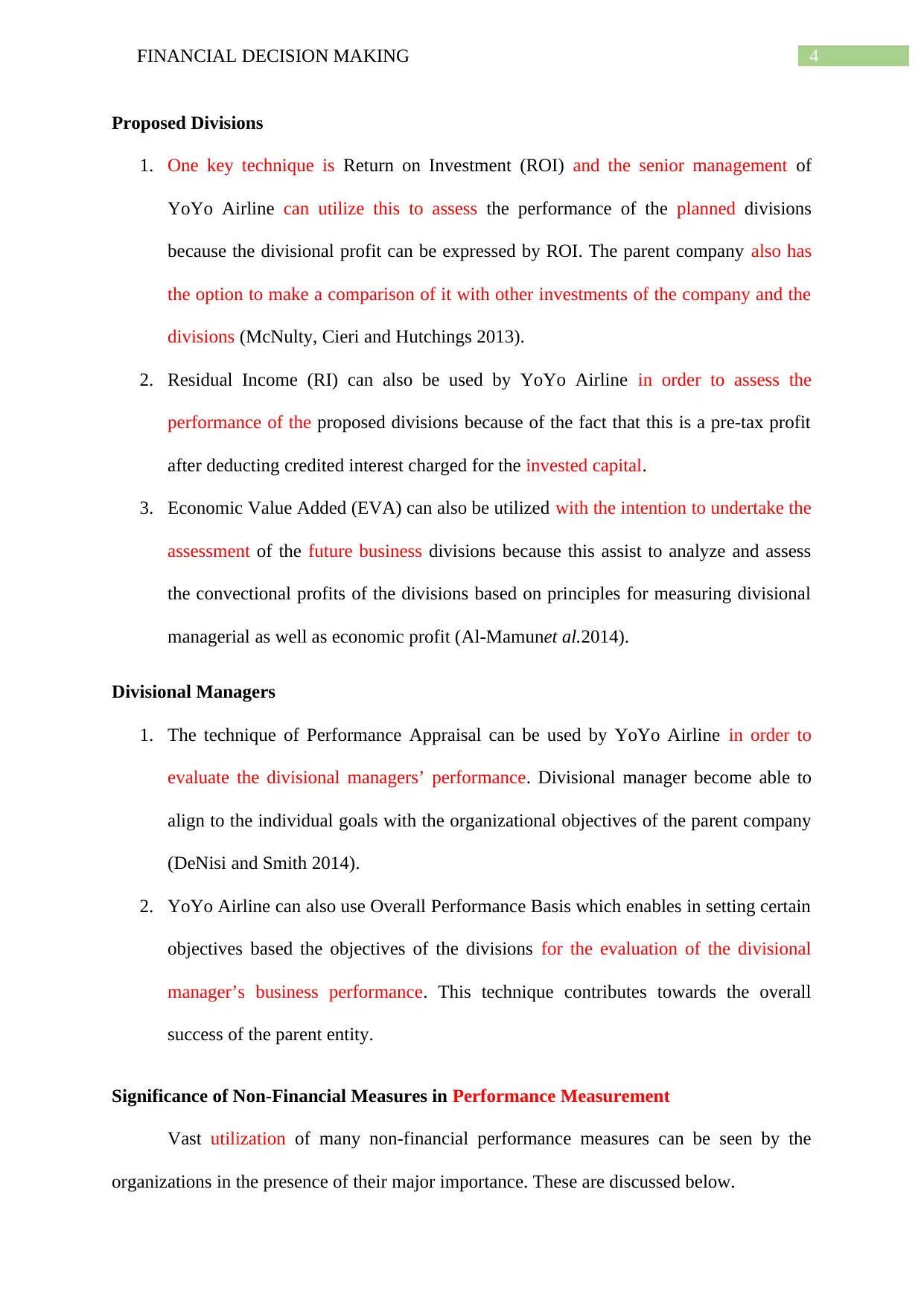
4FINANCIAL DECISION MAKING
Proposed Divisions
1. One key technique is Return on Investment (ROI) and the senior management of
YoYo Airline can utilize this to assess the performance of the planned divisions
because the divisional profit can be expressed by ROI. The parent company also has
the option to make a comparison of it with other investments of the company and the
divisions (McNulty, Cieri and Hutchings 2013).
2. Residual Income (RI) can also be used by YoYo Airline in order to assess the
performance of the proposed divisions because of the fact that this is a pre-tax profit
after deducting credited interest charged for the invested capital.
3. Economic Value Added (EVA) can also be utilized with the intention to undertake the
assessment of the future business divisions because this assist to analyze and assess
the convectional profits of the divisions based on principles for measuring divisional
managerial as well as economic profit (Al-Mamunet al.2014).
Divisional Managers
1. The technique of Performance Appraisal can be used by YoYo Airline in order to
evaluate the divisional managers’ performance. Divisional manager become able to
align to the individual goals with the organizational objectives of the parent company
(DeNisi and Smith 2014).
2. YoYo Airline can also use Overall Performance Basis which enables in setting certain
objectives based the objectives of the divisions for the evaluation of the divisional
manager’s business performance. This technique contributes towards the overall
success of the parent entity.
Significance of Non-Financial Measures in Performance Measurement
Vast utilization of many non-financial performance measures can be seen by the
organizations in the presence of their major importance. These are discussed below.
Proposed Divisions
1. One key technique is Return on Investment (ROI) and the senior management of
YoYo Airline can utilize this to assess the performance of the planned divisions
because the divisional profit can be expressed by ROI. The parent company also has
the option to make a comparison of it with other investments of the company and the
divisions (McNulty, Cieri and Hutchings 2013).
2. Residual Income (RI) can also be used by YoYo Airline in order to assess the
performance of the proposed divisions because of the fact that this is a pre-tax profit
after deducting credited interest charged for the invested capital.
3. Economic Value Added (EVA) can also be utilized with the intention to undertake the
assessment of the future business divisions because this assist to analyze and assess
the convectional profits of the divisions based on principles for measuring divisional
managerial as well as economic profit (Al-Mamunet al.2014).
Divisional Managers
1. The technique of Performance Appraisal can be used by YoYo Airline in order to
evaluate the divisional managers’ performance. Divisional manager become able to
align to the individual goals with the organizational objectives of the parent company
(DeNisi and Smith 2014).
2. YoYo Airline can also use Overall Performance Basis which enables in setting certain
objectives based the objectives of the divisions for the evaluation of the divisional
manager’s business performance. This technique contributes towards the overall
success of the parent entity.
Significance of Non-Financial Measures in Performance Measurement
Vast utilization of many non-financial performance measures can be seen by the
organizations in the presence of their major importance. These are discussed below.
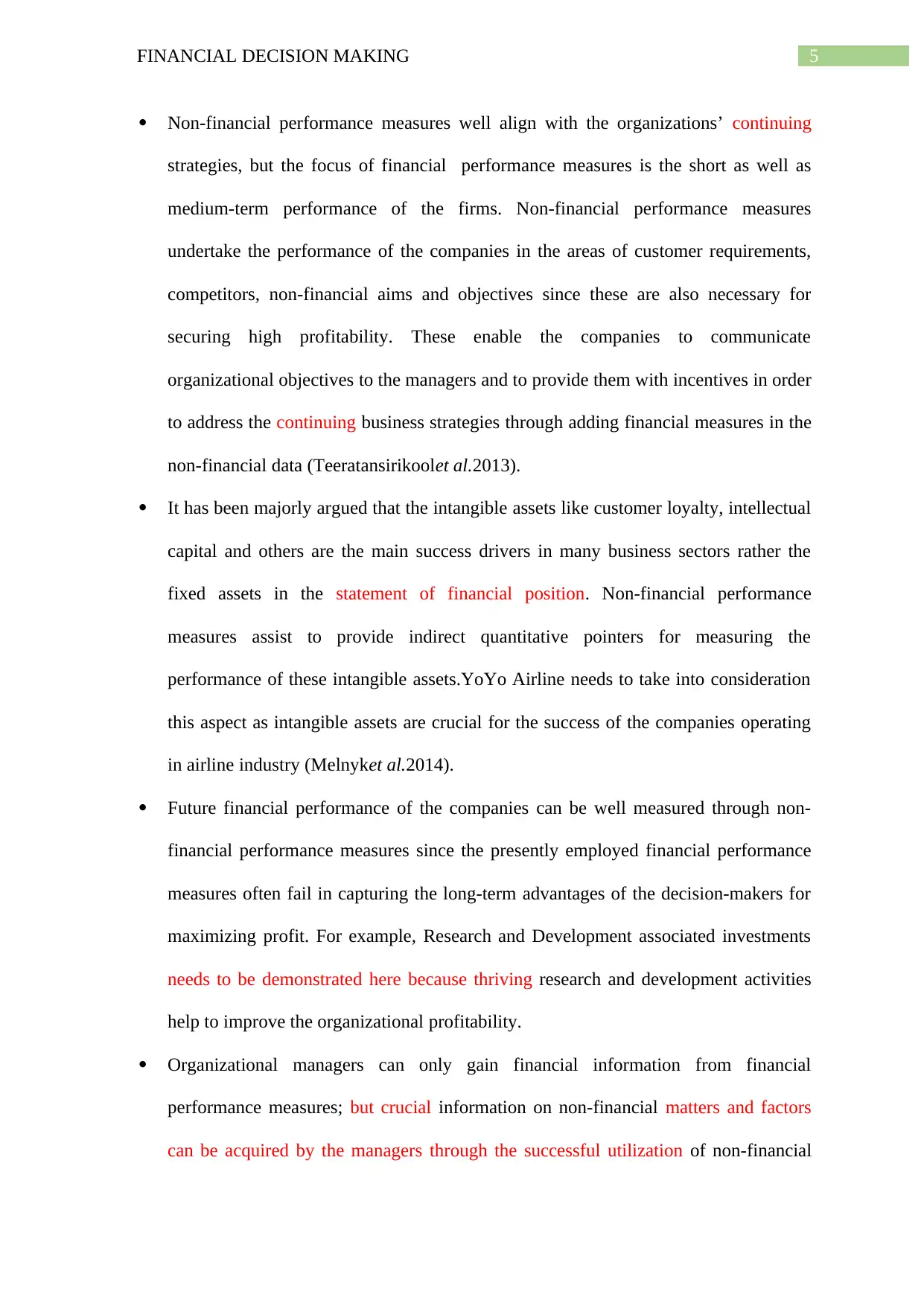
5FINANCIAL DECISION MAKING
Non-financial performance measures well align with the organizations’ continuing
strategies, but the focus of financial performance measures is the short as well as
medium-term performance of the firms. Non-financial performance measures
undertake the performance of the companies in the areas of customer requirements,
competitors, non-financial aims and objectives since these are also necessary for
securing high profitability. These enable the companies to communicate
organizational objectives to the managers and to provide them with incentives in order
to address the continuing business strategies through adding financial measures in the
non-financial data (Teeratansirikoolet al.2013).
It has been majorly argued that the intangible assets like customer loyalty, intellectual
capital and others are the main success drivers in many business sectors rather the
fixed assets in the statement of financial position. Non-financial performance
measures assist to provide indirect quantitative pointers for measuring the
performance of these intangible assets.YoYo Airline needs to take into consideration
this aspect as intangible assets are crucial for the success of the companies operating
in airline industry (Melnyket al.2014).
Future financial performance of the companies can be well measured through non-
financial performance measures since the presently employed financial performance
measures often fail in capturing the long-term advantages of the decision-makers for
maximizing profit. For example, Research and Development associated investments
needs to be demonstrated here because thriving research and development activities
help to improve the organizational profitability.
Organizational managers can only gain financial information from financial
performance measures; but crucial information on non-financial matters and factors
can be acquired by the managers through the successful utilization of non-financial
Non-financial performance measures well align with the organizations’ continuing
strategies, but the focus of financial performance measures is the short as well as
medium-term performance of the firms. Non-financial performance measures
undertake the performance of the companies in the areas of customer requirements,
competitors, non-financial aims and objectives since these are also necessary for
securing high profitability. These enable the companies to communicate
organizational objectives to the managers and to provide them with incentives in order
to address the continuing business strategies through adding financial measures in the
non-financial data (Teeratansirikoolet al.2013).
It has been majorly argued that the intangible assets like customer loyalty, intellectual
capital and others are the main success drivers in many business sectors rather the
fixed assets in the statement of financial position. Non-financial performance
measures assist to provide indirect quantitative pointers for measuring the
performance of these intangible assets.YoYo Airline needs to take into consideration
this aspect as intangible assets are crucial for the success of the companies operating
in airline industry (Melnyket al.2014).
Future financial performance of the companies can be well measured through non-
financial performance measures since the presently employed financial performance
measures often fail in capturing the long-term advantages of the decision-makers for
maximizing profit. For example, Research and Development associated investments
needs to be demonstrated here because thriving research and development activities
help to improve the organizational profitability.
Organizational managers can only gain financial information from financial
performance measures; but crucial information on non-financial matters and factors
can be acquired by the managers through the successful utilization of non-financial
⊘ This is a preview!⊘
Do you want full access?
Subscribe today to unlock all pages.

Trusted by 1+ million students worldwide
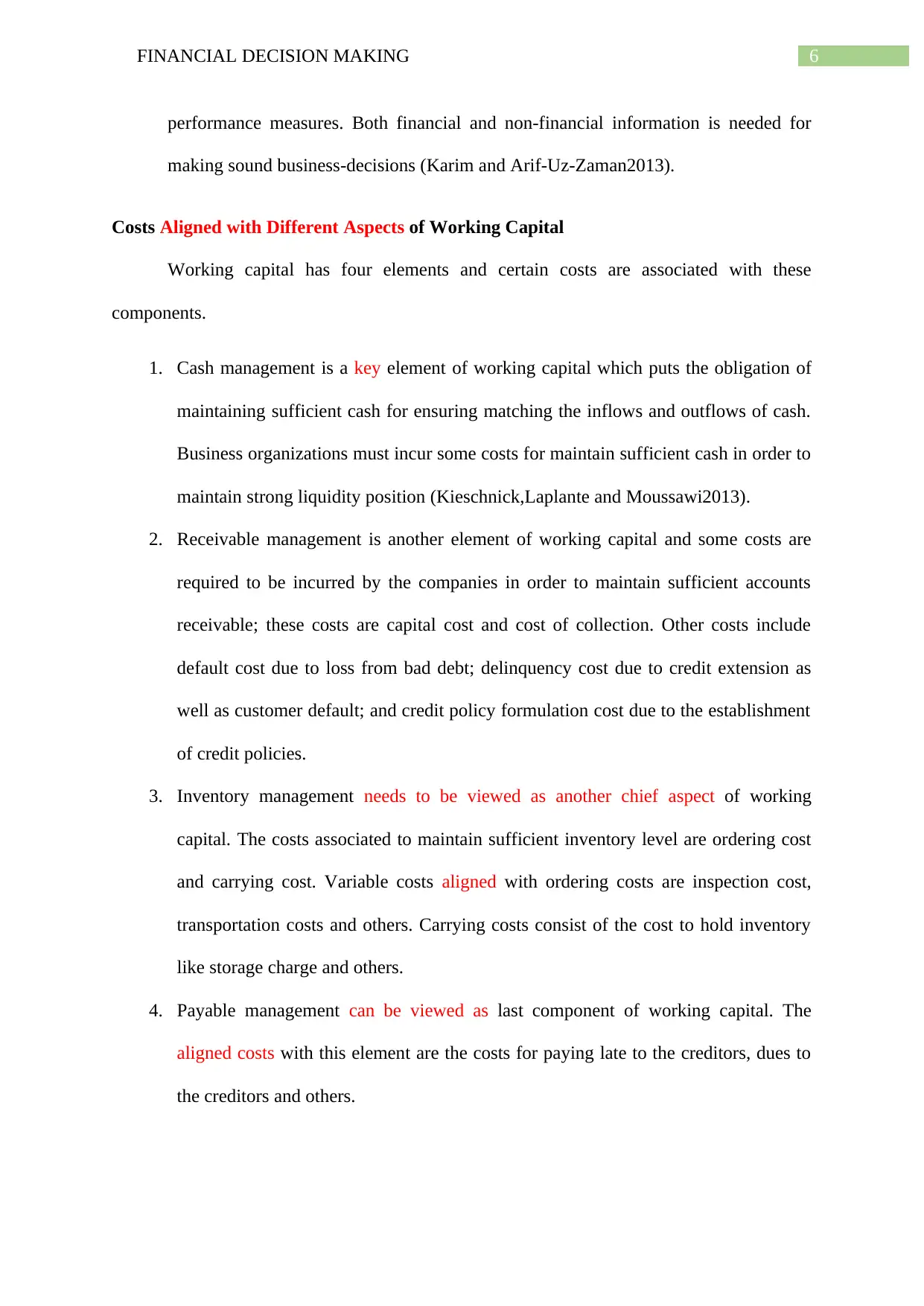
6FINANCIAL DECISION MAKING
performance measures. Both financial and non-financial information is needed for
making sound business-decisions (Karim and Arif-Uz-Zaman2013).
Costs Aligned with Different Aspects of Working Capital
Working capital has four elements and certain costs are associated with these
components.
1. Cash management is a key element of working capital which puts the obligation of
maintaining sufficient cash for ensuring matching the inflows and outflows of cash.
Business organizations must incur some costs for maintain sufficient cash in order to
maintain strong liquidity position (Kieschnick,Laplante and Moussawi2013).
2. Receivable management is another element of working capital and some costs are
required to be incurred by the companies in order to maintain sufficient accounts
receivable; these costs are capital cost and cost of collection. Other costs include
default cost due to loss from bad debt; delinquency cost due to credit extension as
well as customer default; and credit policy formulation cost due to the establishment
of credit policies.
3. Inventory management needs to be viewed as another chief aspect of working
capital. The costs associated to maintain sufficient inventory level are ordering cost
and carrying cost. Variable costs aligned with ordering costs are inspection cost,
transportation costs and others. Carrying costs consist of the cost to hold inventory
like storage charge and others.
4. Payable management can be viewed as last component of working capital. The
aligned costs with this element are the costs for paying late to the creditors, dues to
the creditors and others.
performance measures. Both financial and non-financial information is needed for
making sound business-decisions (Karim and Arif-Uz-Zaman2013).
Costs Aligned with Different Aspects of Working Capital
Working capital has four elements and certain costs are associated with these
components.
1. Cash management is a key element of working capital which puts the obligation of
maintaining sufficient cash for ensuring matching the inflows and outflows of cash.
Business organizations must incur some costs for maintain sufficient cash in order to
maintain strong liquidity position (Kieschnick,Laplante and Moussawi2013).
2. Receivable management is another element of working capital and some costs are
required to be incurred by the companies in order to maintain sufficient accounts
receivable; these costs are capital cost and cost of collection. Other costs include
default cost due to loss from bad debt; delinquency cost due to credit extension as
well as customer default; and credit policy formulation cost due to the establishment
of credit policies.
3. Inventory management needs to be viewed as another chief aspect of working
capital. The costs associated to maintain sufficient inventory level are ordering cost
and carrying cost. Variable costs aligned with ordering costs are inspection cost,
transportation costs and others. Carrying costs consist of the cost to hold inventory
like storage charge and others.
4. Payable management can be viewed as last component of working capital. The
aligned costs with this element are the costs for paying late to the creditors, dues to
the creditors and others.
Paraphrase This Document
Need a fresh take? Get an instant paraphrase of this document with our AI Paraphraser
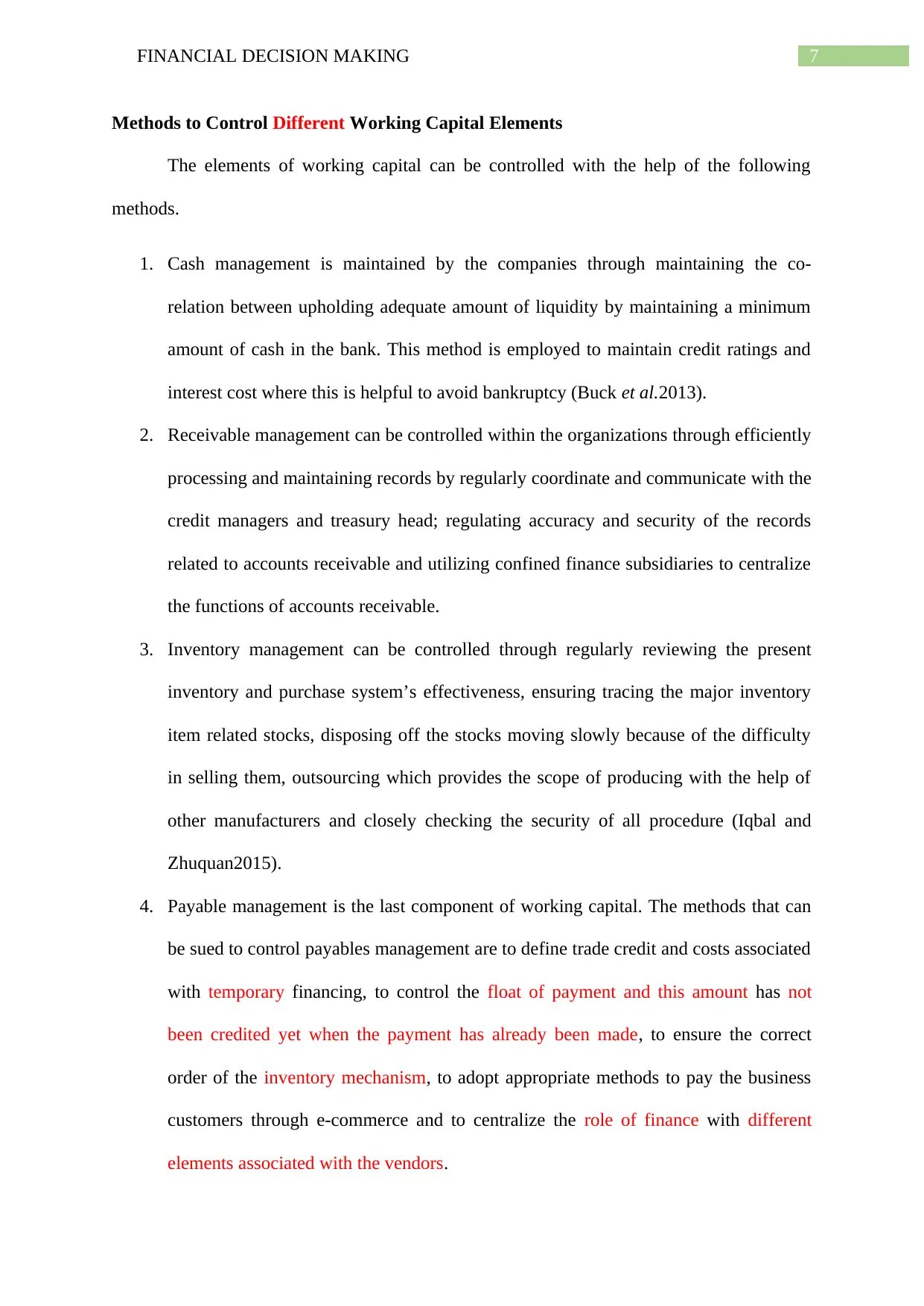
7FINANCIAL DECISION MAKING
Methods to Control Different Working Capital Elements
The elements of working capital can be controlled with the help of the following
methods.
1. Cash management is maintained by the companies through maintaining the co-
relation between upholding adequate amount of liquidity by maintaining a minimum
amount of cash in the bank. This method is employed to maintain credit ratings and
interest cost where this is helpful to avoid bankruptcy (Buck et al.2013).
2. Receivable management can be controlled within the organizations through efficiently
processing and maintaining records by regularly coordinate and communicate with the
credit managers and treasury head; regulating accuracy and security of the records
related to accounts receivable and utilizing confined finance subsidiaries to centralize
the functions of accounts receivable.
3. Inventory management can be controlled through regularly reviewing the present
inventory and purchase system’s effectiveness, ensuring tracing the major inventory
item related stocks, disposing off the stocks moving slowly because of the difficulty
in selling them, outsourcing which provides the scope of producing with the help of
other manufacturers and closely checking the security of all procedure (Iqbal and
Zhuquan2015).
4. Payable management is the last component of working capital. The methods that can
be sued to control payables management are to define trade credit and costs associated
with temporary financing, to control the float of payment and this amount has not
been credited yet when the payment has already been made, to ensure the correct
order of the inventory mechanism, to adopt appropriate methods to pay the business
customers through e-commerce and to centralize the role of finance with different
elements associated with the vendors.
Methods to Control Different Working Capital Elements
The elements of working capital can be controlled with the help of the following
methods.
1. Cash management is maintained by the companies through maintaining the co-
relation between upholding adequate amount of liquidity by maintaining a minimum
amount of cash in the bank. This method is employed to maintain credit ratings and
interest cost where this is helpful to avoid bankruptcy (Buck et al.2013).
2. Receivable management can be controlled within the organizations through efficiently
processing and maintaining records by regularly coordinate and communicate with the
credit managers and treasury head; regulating accuracy and security of the records
related to accounts receivable and utilizing confined finance subsidiaries to centralize
the functions of accounts receivable.
3. Inventory management can be controlled through regularly reviewing the present
inventory and purchase system’s effectiveness, ensuring tracing the major inventory
item related stocks, disposing off the stocks moving slowly because of the difficulty
in selling them, outsourcing which provides the scope of producing with the help of
other manufacturers and closely checking the security of all procedure (Iqbal and
Zhuquan2015).
4. Payable management is the last component of working capital. The methods that can
be sued to control payables management are to define trade credit and costs associated
with temporary financing, to control the float of payment and this amount has not
been credited yet when the payment has already been made, to ensure the correct
order of the inventory mechanism, to adopt appropriate methods to pay the business
customers through e-commerce and to centralize the role of finance with different
elements associated with the vendors.
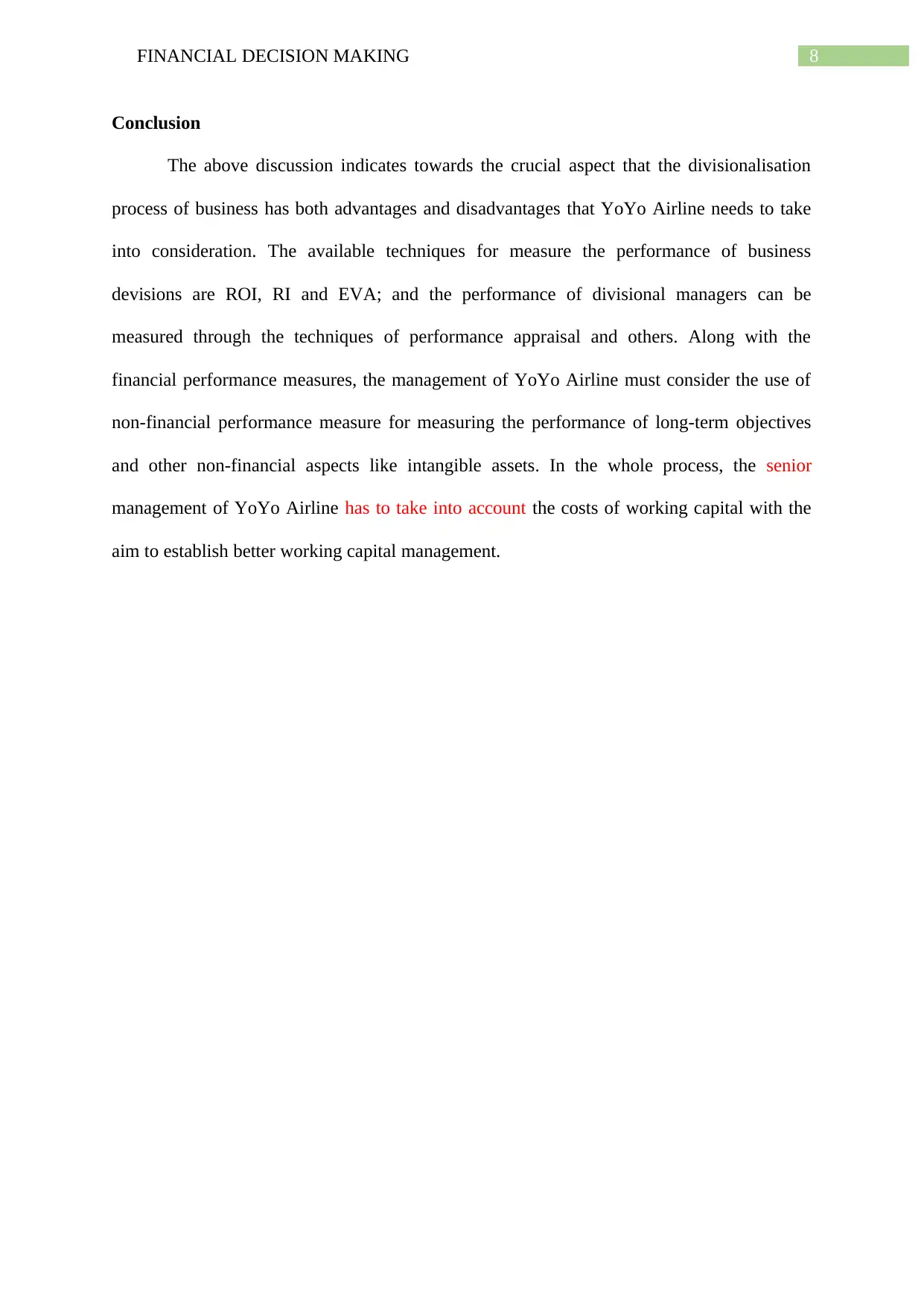
8FINANCIAL DECISION MAKING
Conclusion
The above discussion indicates towards the crucial aspect that the divisionalisation
process of business has both advantages and disadvantages that YoYo Airline needs to take
into consideration. The available techniques for measure the performance of business
devisions are ROI, RI and EVA; and the performance of divisional managers can be
measured through the techniques of performance appraisal and others. Along with the
financial performance measures, the management of YoYo Airline must consider the use of
non-financial performance measure for measuring the performance of long-term objectives
and other non-financial aspects like intangible assets. In the whole process, the senior
management of YoYo Airline has to take into account the costs of working capital with the
aim to establish better working capital management.
Conclusion
The above discussion indicates towards the crucial aspect that the divisionalisation
process of business has both advantages and disadvantages that YoYo Airline needs to take
into consideration. The available techniques for measure the performance of business
devisions are ROI, RI and EVA; and the performance of divisional managers can be
measured through the techniques of performance appraisal and others. Along with the
financial performance measures, the management of YoYo Airline must consider the use of
non-financial performance measure for measuring the performance of long-term objectives
and other non-financial aspects like intangible assets. In the whole process, the senior
management of YoYo Airline has to take into account the costs of working capital with the
aim to establish better working capital management.
⊘ This is a preview!⊘
Do you want full access?
Subscribe today to unlock all pages.

Trusted by 1+ million students worldwide
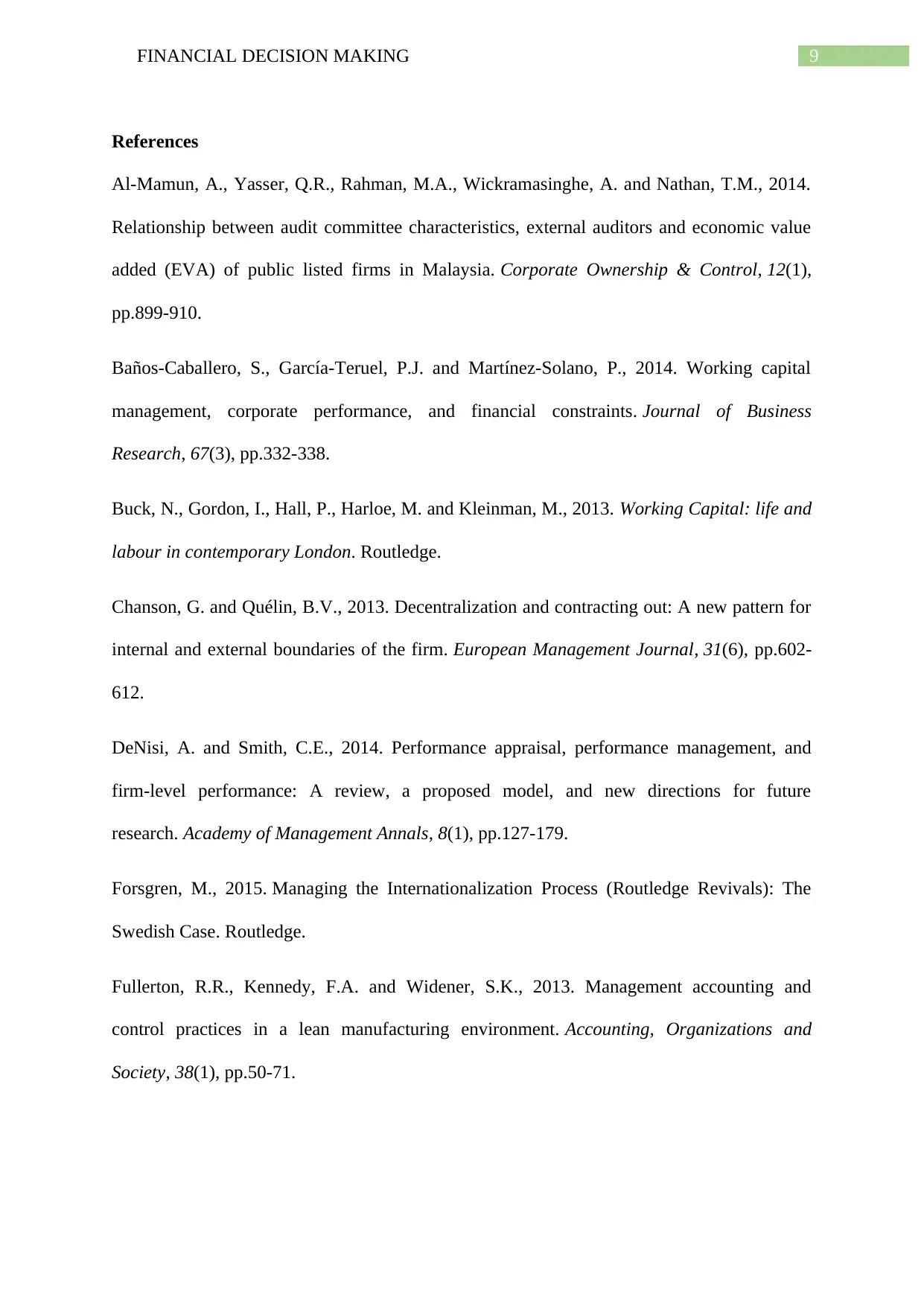
9FINANCIAL DECISION MAKING
References
Al-Mamun, A., Yasser, Q.R., Rahman, M.A., Wickramasinghe, A. and Nathan, T.M., 2014.
Relationship between audit committee characteristics, external auditors and economic value
added (EVA) of public listed firms in Malaysia. Corporate Ownership & Control, 12(1),
pp.899-910.
Baños-Caballero, S., García-Teruel, P.J. and Martínez-Solano, P., 2014. Working capital
management, corporate performance, and financial constraints. Journal of Business
Research, 67(3), pp.332-338.
Buck, N., Gordon, I., Hall, P., Harloe, M. and Kleinman, M., 2013. Working Capital: life and
labour in contemporary London. Routledge.
Chanson, G. and Quélin, B.V., 2013. Decentralization and contracting out: A new pattern for
internal and external boundaries of the firm. European Management Journal, 31(6), pp.602-
612.
DeNisi, A. and Smith, C.E., 2014. Performance appraisal, performance management, and
firm-level performance: A review, a proposed model, and new directions for future
research. Academy of Management Annals, 8(1), pp.127-179.
Forsgren, M., 2015. Managing the Internationalization Process (Routledge Revivals): The
Swedish Case. Routledge.
Fullerton, R.R., Kennedy, F.A. and Widener, S.K., 2013. Management accounting and
control practices in a lean manufacturing environment. Accounting, Organizations and
Society, 38(1), pp.50-71.
References
Al-Mamun, A., Yasser, Q.R., Rahman, M.A., Wickramasinghe, A. and Nathan, T.M., 2014.
Relationship between audit committee characteristics, external auditors and economic value
added (EVA) of public listed firms in Malaysia. Corporate Ownership & Control, 12(1),
pp.899-910.
Baños-Caballero, S., García-Teruel, P.J. and Martínez-Solano, P., 2014. Working capital
management, corporate performance, and financial constraints. Journal of Business
Research, 67(3), pp.332-338.
Buck, N., Gordon, I., Hall, P., Harloe, M. and Kleinman, M., 2013. Working Capital: life and
labour in contemporary London. Routledge.
Chanson, G. and Quélin, B.V., 2013. Decentralization and contracting out: A new pattern for
internal and external boundaries of the firm. European Management Journal, 31(6), pp.602-
612.
DeNisi, A. and Smith, C.E., 2014. Performance appraisal, performance management, and
firm-level performance: A review, a proposed model, and new directions for future
research. Academy of Management Annals, 8(1), pp.127-179.
Forsgren, M., 2015. Managing the Internationalization Process (Routledge Revivals): The
Swedish Case. Routledge.
Fullerton, R.R., Kennedy, F.A. and Widener, S.K., 2013. Management accounting and
control practices in a lean manufacturing environment. Accounting, Organizations and
Society, 38(1), pp.50-71.
Paraphrase This Document
Need a fresh take? Get an instant paraphrase of this document with our AI Paraphraser
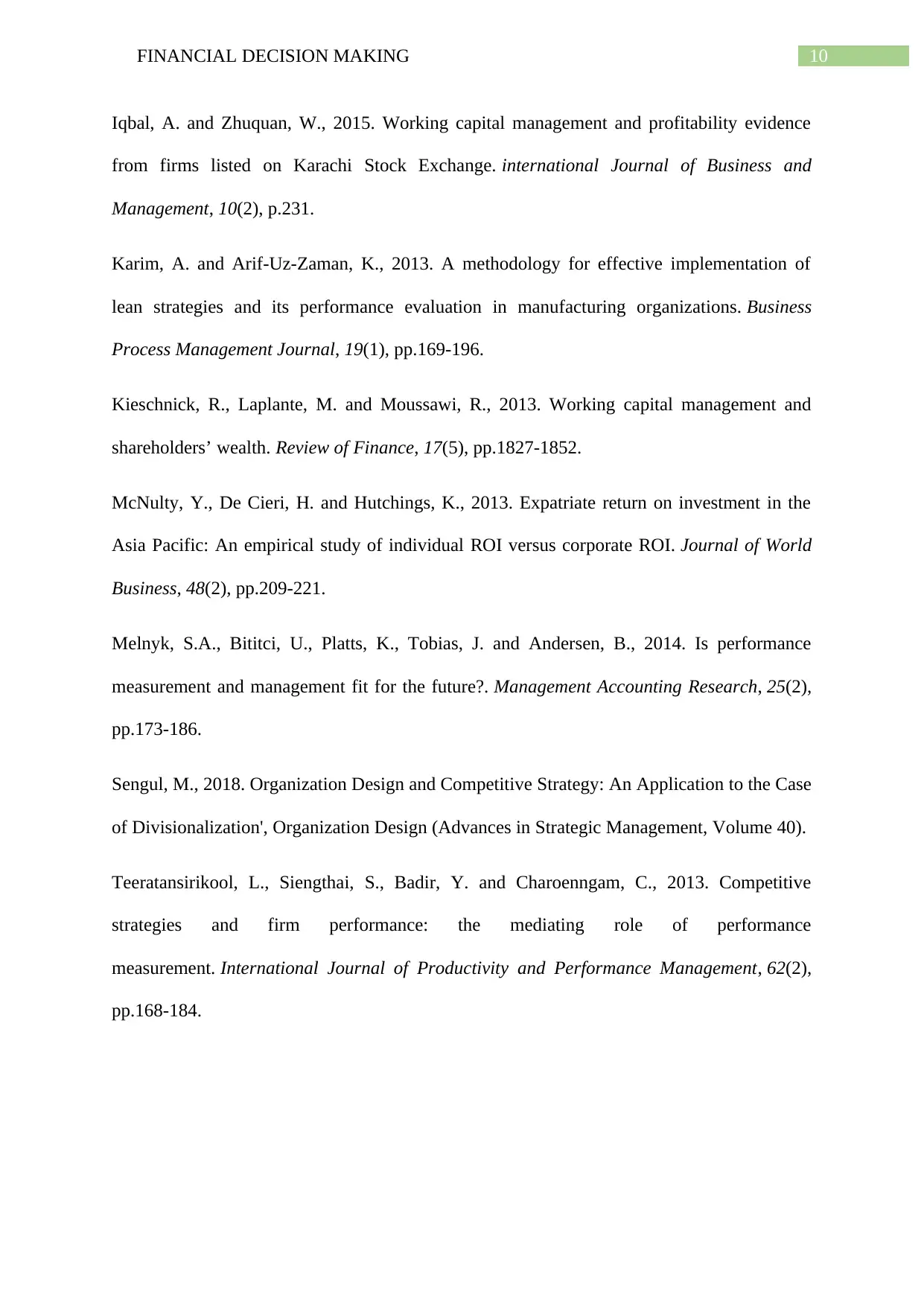
10FINANCIAL DECISION MAKING
Iqbal, A. and Zhuquan, W., 2015. Working capital management and profitability evidence
from firms listed on Karachi Stock Exchange. international Journal of Business and
Management, 10(2), p.231.
Karim, A. and Arif-Uz-Zaman, K., 2013. A methodology for effective implementation of
lean strategies and its performance evaluation in manufacturing organizations. Business
Process Management Journal, 19(1), pp.169-196.
Kieschnick, R., Laplante, M. and Moussawi, R., 2013. Working capital management and
shareholders’ wealth. Review of Finance, 17(5), pp.1827-1852.
McNulty, Y., De Cieri, H. and Hutchings, K., 2013. Expatriate return on investment in the
Asia Pacific: An empirical study of individual ROI versus corporate ROI. Journal of World
Business, 48(2), pp.209-221.
Melnyk, S.A., Bititci, U., Platts, K., Tobias, J. and Andersen, B., 2014. Is performance
measurement and management fit for the future?. Management Accounting Research, 25(2),
pp.173-186.
Sengul, M., 2018. Organization Design and Competitive Strategy: An Application to the Case
of Divisionalization', Organization Design (Advances in Strategic Management, Volume 40).
Teeratansirikool, L., Siengthai, S., Badir, Y. and Charoenngam, C., 2013. Competitive
strategies and firm performance: the mediating role of performance
measurement. International Journal of Productivity and Performance Management, 62(2),
pp.168-184.
Iqbal, A. and Zhuquan, W., 2015. Working capital management and profitability evidence
from firms listed on Karachi Stock Exchange. international Journal of Business and
Management, 10(2), p.231.
Karim, A. and Arif-Uz-Zaman, K., 2013. A methodology for effective implementation of
lean strategies and its performance evaluation in manufacturing organizations. Business
Process Management Journal, 19(1), pp.169-196.
Kieschnick, R., Laplante, M. and Moussawi, R., 2013. Working capital management and
shareholders’ wealth. Review of Finance, 17(5), pp.1827-1852.
McNulty, Y., De Cieri, H. and Hutchings, K., 2013. Expatriate return on investment in the
Asia Pacific: An empirical study of individual ROI versus corporate ROI. Journal of World
Business, 48(2), pp.209-221.
Melnyk, S.A., Bititci, U., Platts, K., Tobias, J. and Andersen, B., 2014. Is performance
measurement and management fit for the future?. Management Accounting Research, 25(2),
pp.173-186.
Sengul, M., 2018. Organization Design and Competitive Strategy: An Application to the Case
of Divisionalization', Organization Design (Advances in Strategic Management, Volume 40).
Teeratansirikool, L., Siengthai, S., Badir, Y. and Charoenngam, C., 2013. Competitive
strategies and firm performance: the mediating role of performance
measurement. International Journal of Productivity and Performance Management, 62(2),
pp.168-184.
1 out of 11
Related Documents
Your All-in-One AI-Powered Toolkit for Academic Success.
+13062052269
info@desklib.com
Available 24*7 on WhatsApp / Email
![[object Object]](/_next/static/media/star-bottom.7253800d.svg)
Unlock your academic potential
Copyright © 2020–2025 A2Z Services. All Rights Reserved. Developed and managed by ZUCOL.




